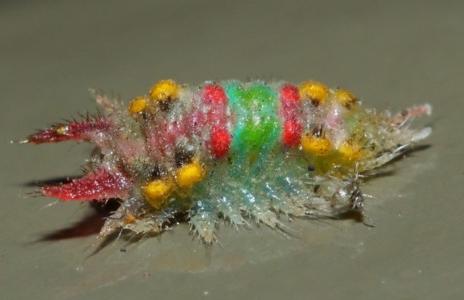
first instar magnified
(Photo: courtesy of Tim Leach,
Australian National Botanical Gardens, Australian Capital Territory)
These Caterpillars sting.
The first instar
caterpillars of this species are tiny but spectacular.
They are red, yellow, black, and green,
with fleshy spikes protruding from the ends and the sides.
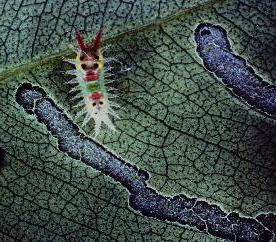
early instar and feeding grooves
(Photo: courtesy of Merlin Crossley, Melbourne, Victoria)
When they hatch from their eggs: the caterpillars separate,
and each makes a characteristic groove
on the surface of a leaf as it feeds.
This behaviour differs from that of the caterpillars of
Doratifera vulnerans and
Doratifera quadriguttata,
which feed communally,
and destroy the whole leaf surface.
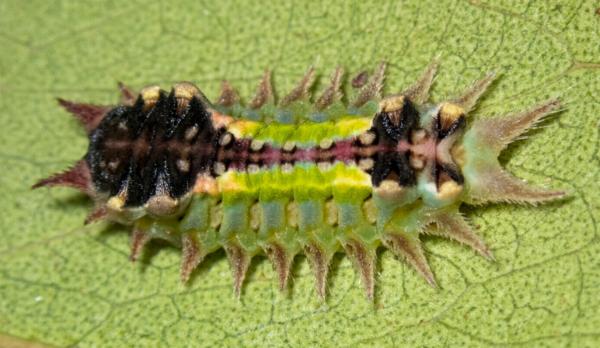
black variety
(Photo: courtesy of
David Akers,
Won Wron, Victoria)
The basic colour of the mature caterpillar is green,
but it is decorated with a number of markings.
There are two shield-like patches on its back:
a larger one at the front, and a smaller one at the back.
The basic colour of the shields varies from pale grey to red to black.
The shields also contain yellow triangular spots ringed with black.
A dorsal line
the same colour as the shields connects them.
The shields are surrounded by thin yellow line.
In all but the last instar,
this is surrounded by a red band.
Each shield bears four tubercles.
Yellow
stinging hairs are protruded from these
when the caterpillar is disturbed.
These fold into triangular pockets
when the caterpillar is relaxed.
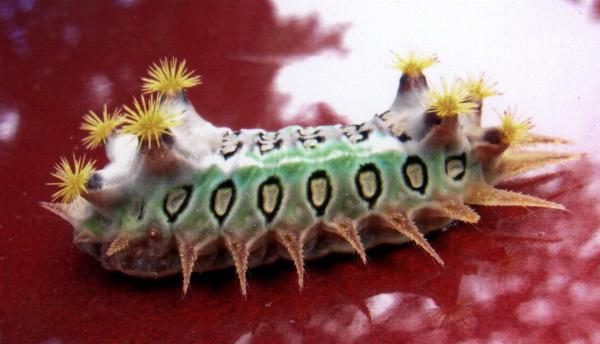
grey variety, with stinging hairs everted
(Photo: courtesy of Albert Goede, Hobart, Tasmania)
On each side of each abdominal segment is a
black-edged yellow elliptical spiracle above a fleshy spike.
The spikes are translucent, and can be reddish or yellowish.
The front pair are especially likely to be red.
The lateral spikes together look like a skirt.
There is also a flap covering the head.
The caterpillars move like slugs because their legs are reduced.
The caterpillars feed on a variety of:
Gum Trees ( Eucalyptus,
MYRTACEAE ),
and grow to length of about 2.5 cms.
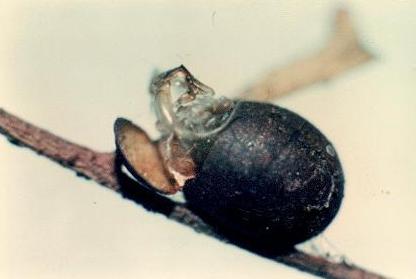
cocoon after eclosion of pupal skin and departure of adult
(Photo: courtesy of the
Macleay Collection, Chau Chak Wing Museum, University of Sydney)
The pupa is enclosed in a strong woody ellipsoidal cocoon,
which is usually attached on its side to a twig
(unlike
Doratifera vulnerans).
The pupal period can be nine months.
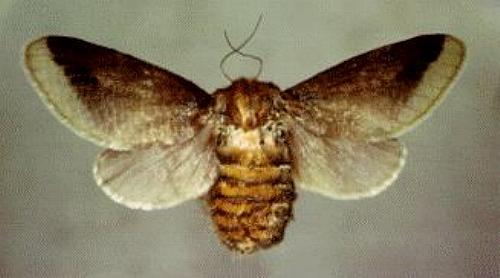
adult female
(Specimen: courtesy of the
Macleay Collection, Chau Chak Wing Museum, University of Sydney)
The adults are dimorphic. The female has brown wings, with a
pale edge, and a wingspan of 5 cms.
She has a stout body covered with orange scales.
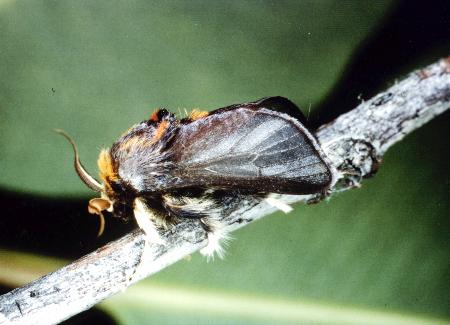
adult male
(Photo: courtesy of Merlin Crossley, Melbourne, Victoria)
The males have transparent wings with a bluish tinge.
They have hairs all over the body,
which are orange on the back,
and white underneath, on the legs, and on the tip of the abdomen.
The male moths have a wingspan of about 2 cms.
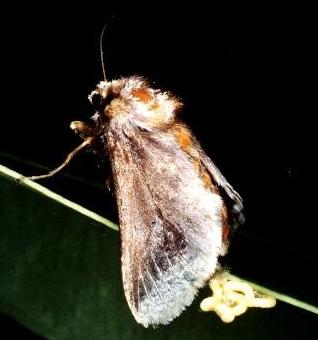
female laying eggs
(Photo: courtesy of Merlin Crossley, Melbourne, Victoria)
The eggs are laid in clusters of 40 or so,
and are covered by hair by the mother moth.
Eggs laid in April in Melbourne hatched 12 days later.
The species has been found in
New South Wales,
Australian Capital Territory,
Victoria,
Tasmania,
South Australia, and
Western Australia.
Further reading :
Ian F.B. Common,
Moths of Australia,
Melbourne University Press, 1990, pls. 8.4, 8.6, 25.3, pp. 67, 69, 302.
Pat and Mike Coupar,
Flying Colours,
New South Wales University Press, Sydney 1992, p. 60.
Peter B. McQuillan, Jan A. Forrest, David Keane, & Roger Grund,
Caterpillars, moths, and their plants of Southern Australia,
Butterfly Conservation South Australia Inc., Adelaide (2019), p. 75.
Edward Newman,
Characters and some Account of the Economy of a supposed New Species of Australian Bombyx,
Zoologist,
Volume 13 (1855), pp. ccxi-ccxii.
(updated 6 February 2012, 18 May 2023)













